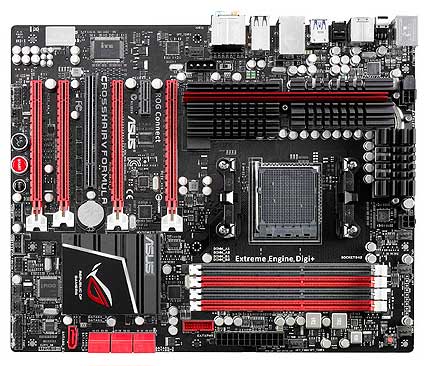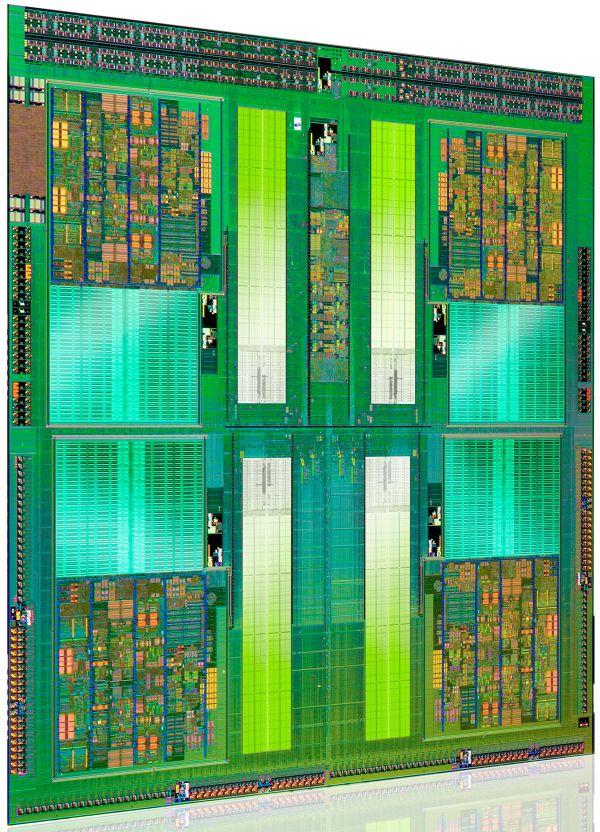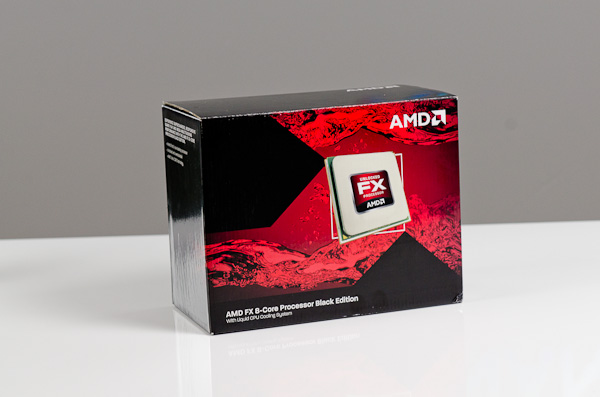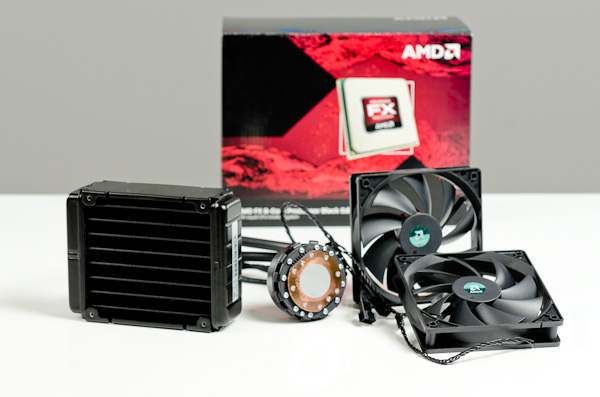The Bulldozer Review: AMD FX-8150 Tested
by Anand Lal Shimpi on October 12, 2011 1:27 AM ESTAMD has been trailing Intel in the x86 performance space for years now. Ever since the introduction of the first Core 2 processors in 2006, AMD hasn't been able to recover and return to the heyday of the Athlon 64 and Athlon 64 X2. Instead the company has remained relevant by driving costs down and competing largely in the sub-$200 microprocessor space. AMD's ability to hold on was largely due to its more-cores-for-less strategy. Thanks to aggressive pricing on its triple and hexa-core parts, for users who needed tons of cores, AMD has been delivering a lot of value over the past couple of years.
Recently however Intel has been able to drive its per-core performance up with Sandy Bridge, where it's becoming increasingly difficult to recommend AMD alternatives with higher core counts. The heavily threaded desktop niche is tough to sell to, particularly when you force users to take a significant hit on single threaded performance in order to achieve value there. For a while now AMD has needed a brand new architecture, something that could lead to dominance in heavily threaded workloads while addressing its deficiencies in lightly threaded consumer workloads. After much waiting, we get that new architecture today. Bulldozer is here.
It's branded the AMD FX processor and it's only available in a single die configuration. Measuring 315mm2 and weighing in at around 2 billion transistors (that's nearly GPU-sized fellas), Bulldozer isn't that much smaller than existing 45nm 6-core Phenom II designs despite being built on Global Foundries' 32nm SOI process. Both die area and transistor count are up significantly over Sandy Bridge, which on Intel's 32nm HKMG process is only 995M transistors with a die size of 216mm2. This is one big chip.
| CPU Specification Comparison | ||||||||
| CPU | Manufacturing Process | Cores | Transistor Count | Die Size | ||||
| AMD Bulldozer 8C | 32nm | 8 | 1.2B* | 315mm2 | ||||
| AMD Thuban 6C | 45nm | 6 | 904M | 346mm2 | ||||
| AMD Deneb 4C | 45nm | 4 | 758M | 258mm2 | ||||
| Intel Gulftown 6C | 32nm | 6 | 1.17B | 240mm2 | ||||
| Intel Nehalem/Bloomfield 4C | 45nm | 4 | 731M | 263mm2 | ||||
| Intel Sandy Bridge 4C | 32nm | 4 | 995M | 216mm2 | ||||
| Intel Lynnfield 4C | 45nm | 4 | 774M | 296mm2 | ||||
| Intel Clarkdale 2C | 32nm | 2 | 384M | 81mm2 | ||||
| Intel Sandy Bridge 2C (GT1) | 32nm | 2 | 504M | 131mm2 | ||||
| Intel Sandy Bridge 2C (GT2) | 32nm | 2 | 624M | 149mm2 | ||||
Update: AMD originally told us Bulldozer was a 2B transistor chip. It has since told us that the 8C Bulldozer is actually 1.2B transistors. The die size is still accurate at 315mm2.
Architecturally Bulldozer is a significant departure from anything we've ever seen before. We'll go into greater detail later on in this piece, but the building block in AMD's latest architecture is the Bulldozer module. Each module features two integer cores and a shared floating point core. FP hardware is larger and used less frequently in desktop (and server workloads), so AMD decided to share it between every two cores rather than offer a 1:1 ratio between int/fp cores on Bulldozer. AMD advertises Bulldozer based FX parts based on the number of integer cores. Thus a two module Bulldozer CPU, has four integer cores (and 2 FP cores) and is thus sold as a quad-core CPU. A four module Bulldozer part with eight integer cores is called an eight-core CPU. There are obvious implications from a performance standpoint, but we'll get to those shortly.
The FX Lineup
There are a total of 7 AMD FX CPUs that AMD is announcing today, although only four are slated for near-term availability.
| CPU Specification Comparison | |||||||||
| Processor | Cores | Clock Speed | Max Turbo | NB Clock | L2 Cache | TDP | Price | ||
| AMD FX-8150 | 8 | 3.6GHz | 4.2GHz | 2.2GHz | 8MB | 125W | $245 | ||
| AMD FX-8120 | 8 | 3.1GHz | 4.0GHz | 2.2GHz | 8MB | 95W/125W | $205 | ||
| AMD FX-8100* | 8 | 2.8GHz | 3.7GHz | 2GHz | 8MB | 95W | N/A | ||
| AMD FX-6100 | 6 | 3.3GHz | 3.9GHz | 2GHz | 6MB | 95W | $165 | ||
| AMD FX-4170* | 4 | 4.2GHz | 4.3GHz | 2.2GHz | 4MB | 125W | N/A | ||
| AMD FX-B4150* | 4 | 3.8GHz | 4GHz | 2.2GHz | 4MB | 95W | N/A | ||
| AMD FX-4100 | 4 | 3.6GHz | 3.8GHz | 2GHz | 4MB | 95W | $115 | ||
| AMD Phenom II X6 1100T | 6 | 3.2GHz | 3.6GHz | 2GHz | 3MB | 125W | $190 | ||
| AMD Phenom II X4 980 | 4 | 3.7GHz | N/A | 2GHz | 2MB | 125W | $170 | ||
The FX-8150, 8120, 6100 and 4100 are what's launching today. The first digit in AMD's FX model numbers indicates the number of cores with the 8150 and 8120 boasting eight, while the 6100 only has six active integer cores (three Bulldozer modules). The FX-4100 features four integer cores. L2 cache scales with core count (2MB per module), while the L3 cache size remains fixed at 8MB regardless of SKU.
North Bridge and L3 cache frequency alternate between 2.0GHz and 2.2GHz depending on the part. TDPs range between 95W and 125W as well, with the FX-8120 being offered in both 125W and 95W versions.
There's only a single Bulldozer die. The 6 and 4 core versions simply feature cores disabled on the die. AMD insists this time around, core unlocking won't be possible on these harvested parts.
The huge gap in clock speed between the 8120 and 8150 are troubling. Typically we see linear frequency graduations but the fact that there's a 16% difference between these two SKUs seems to point to process problems limiting yield at higher frequencies—at least for the 8-core version.
Outside of the quad-core and hex-core Bulldozer pats, the only other FX processor able to exceed the 3.3GHz clock speed of the Phenom II X6 1100T is the 8150. And if you include quad-core Phenom II parts in the mix, only two Bulldozer parts ship at a higher stock frequency than the Phenom II X4 980. Granted Turbo Core will help push frequencies even higher, but these low base frequencies are troubling. For an architecture that was designed to scale to clock speeds 30% higher than its predecessor, Bulldozer doesn't seem to be coming anywhere close.
The entire FX lineup ships unlocked, which allows for some easy overclocking as you'll see soon enough.
Motherboard Compatibility
AMD is certifying its FX processors for use on Socket-AM3+ motherboards. Owners of standard AM3 motherboards may be out of luck, although motherboard manufacturers can choose to certify their boards for use with Bulldozer if they wish to do so. From AMD's perspective however, only AM3+ motherboards with BIOS/UEFI support for Bulldozer are officially supported.
All existing AM2/AM2+/AM3/AM3+ heatsinks should work with the FX processor; they simply need to be rated for the TDP of the processor you're looking to cool.

For this review, AMD supplied us with ASUS' Crosshair V Formula AM3+ motherboard based on AMD's 990FX chipset.
AMD does offer six 6Gbps SATA ports on its 990FX chipset, a significant upgrade from the two 6Gbps ports on Intel's 6-series chipsets. Unbuffered ECC memory is also supported for those who desire the added security, once again a feature not supported on Intel's consumer grade 6-series chipsets.
Despite AMD's trend towards releasing APUs with integrated GPUs (thus requiring a new socket), AMD insists that the AM3+ platform will live to see one more processor generation before it's retired.
AMD's Liquid CPU Cooling System
Alongside its new FX processors AMD is introducing its first branded liquid cooling system manufactured by Asetek.
AMD's cooling system is similar to other offerings from companies like Antec and Corsair. The system is self contained, you never have to worry about adding any more liquid to it.
Attach the cooling module to your CPU socket via a simple bracket, and affix the radiator to your case and you're good to go. The radiator is cooled via two 120mm fans, also included in the box.
AMD doesn't have an exact idea on pricing or availability of its liquid cooling solution, but I'm told to expect it to be around $100 once available. My sample actually arrived less than 12 hours ago, so expect a follow up with performance analysis later this week.
The Roadmap
For the first time in far too long, AMD is actually being very forthcoming about its future plans. At a recent tech day about Bulldozer, AMD laid out its CPU core roadmap through 2014. The code names are below:
Piledriver you already know about, it's at the heart of Trinity, which is the 2—4 core APU due out in early 2012. Piledriver will increase CPU core performance by around 10—15% over Bulldozer, although it will initially appear in a lower performance segment. Remember that final generation of AM3+ CPU I mentioned earlier? I fully expect that to be a GPU-less Piledriver CPU due out sometime in 2012.
Steamroller will follow in 2013, again improving performance (at the core level) by around 10—15%. Excavator will do the same in 2014. AMD believes that these performance increases will be sufficient to keep up with Intel over time, however I'll let you be the judge of that once we get to the Bulldozer performance numbers.
The other thing to note about AMD's roadmap is it effectively puts the x86 business on an annual cadence, in line with what we've seen from the AMD GPU folks. Although AMD isn't talking about what process nodes to expect all of these cores at, it looks like AMD will finally have an answer to Intel's tick-tock release schedule moving forward.























430 Comments
View All Comments
Iketh - Thursday, October 13, 2011 - link
I play FSX and Starcraft 2... both require copious processing power.And I just built an i7-2600K system with a radeon 6870 and blu ray writer for.... $960
paultaylor - Thursday, October 13, 2011 - link
While the benchmarks are very revealing of the "ahead of its time" nature of Bulldozer, I think AMD should've kicked off by focusing on server applications instead of desktop ones.Considering what I've seen so far I think some additional benchmarks on threading/scaling would come in handy – it would actually show the true nature of BD as, right now, it’s behaving like a quad-core processor (due to the shared nature of its architecture, I presume) in most cases, rather than an octacore. Charting that out might be very revealing. The situation now looks like Intel's 2nd (3rd?) generation hyperthreading quad-cores provide more efficient multithreading than 8 physical cores on an AMD FX.
Don’t get me wrong, we’ve heard from the beginning that BD will be optimised for server roles, but then we’re outside the feedback loop. Shouldn’t someone inside AMD be minding the store and making sure the lower shelves are also stocked with something we want?
A longer pipeline and the old “we’ll make it up in MHz” line reeks of Netburst, unfortunately, and we all know how that ended. Looking at the tranny count, it’s got almost twice as many as the Gulftown, with 27% bigger die size for the entire CPU… which will mean poorer yields and higher costs for AMD, not to mention that either the fabbing process is really being tweaked or the speed bumps will not come at all, as the TDP is already high-ish. Ironically it reminds me of Fermi. Speaking of which… BD may become the punchline of many jokes like “What do you get when you cross a Pentium 4 and a Fermi?”
On the other hand it seems AMD has managed one small miracle, their roadmaps will become more predictable (a good thing from a business perspective) and that will exert a positive influence with system integrators. Planning products ahead of the game, in particular in this 12-month cycle, might do some good for AMD, if they survive the overal skepticism that BD is currently "enjoying".
Other than that, another fine unbiased article.
rickcain2320 - Thursday, October 13, 2011 - link
Bulldozer/Zambezi seems to look more like a server CPU repackaged as a consumer grade one. Excellent in heavily threaded apps, not so hot in single threads.One CPU that is promised but isn't here is the FX-4170. I would have liked to see some benchmarks on it.
gvaley - Thursday, October 13, 2011 - link
We all get that. The problem is, with this power consumption, it can't make it into the server space either.kevith - Thursday, October 13, 2011 - link
Having waited so long for this, it´s a bit disappointing, when I compare price/performance.I went from C2D E 7300 acouple of years ago, and changed setup to Athlon II x2 250, and the performance difference made me regret right away.
And now, I have to change my MB and memory to DDR3 no matter what I choose, Intel or AMD. So I´ve looked forward to this release.
And it makes my choice very easy: I´l go back to Intel, no more AMD for me on the CPU side. And Ivy Bridge is coming, and will definetely smoke AMD.
Which is sad, it would have been nice with some competition.
eccl1213 - Thursday, October 13, 2011 - link
Earlier this week most sites reported that the FX and BD based Opteron 4200 and 6200 where both being released on Oct 12th.But I haven't found a single review site with interlagos benchmarks.
Have those parts been further delayed? We know revenue shipment happened a while back but I'm not seeing any mention of them in the wild yet.
xtreme762 - Thursday, October 13, 2011 - link
I haven't bought an Intel chip since 1997. But with this BS bulldozer launch, that is now going to change! amd should be ashamed of themselves. I for one will now sell all of my amd stock and purchase Intel. I will probably only end up with a few shares, but at this point, I cannot see supporting liars and fakes. And I will NEVER buy an amd product again, not a video card, cpu, mobo, not nothing! What a disappointment amd is.....All the amd crap I have will be tossed in the trash. I'm not even going to bother trying to sell it. WooHoo amd made a world record OC with a cpu not worth it's weight in dog poo!
connor4312 - Thursday, October 13, 2011 - link
Very interesting review. I'd be interested to see Bulldozer's benchmarks when it's overclocked, which, if I am correct, is higher than any Intel CPU can go. AMD seems to have made a turnaround in this aspect - Intel CPUs were historically more overclock-able.Suntan - Thursday, October 13, 2011 - link
As always, a very detailed review. But what about the capability of the "value" chips? Namely, is it worth it to spend around $100 to replace an Anthlon X4 with an FX4100?There are a number of us that picked up the X4 a couple years back for its low cost ability to encode and do general NLE editing of video. Is it worthwhile to replace that chip with the FX4100 in our AM3+ mobos? And what kind of improvements will there be?
As you rightly stated, a lot of us are attracted to AMD for their bang-for-buck. Just because the industry as a whole wants to bump up prices endlessly, there are still a lot of us that like to see good comparisons of the performance of CPUs available for around 1 Benjamin.
-Suntan
Pipperox - Thursday, October 13, 2011 - link
Frankly, it seems to me the disappointment of AMD fans to be quite excessive.Worst CPU ever?
What was then Barcelona, which couldn't compete with Core 2?
Bulldozer, set aside old single threaded applications, is slotting between a Core i5 2500 and Core i7 2600K.
Which other AMD CPU outperforms in any single benchmark a Core i7 2600k?
A higher clocked Thuban with 2 extra cores would have been hotter and more expensive to produce.
Setting aside AMD's stupid marketing, the AMD FX-8150 is a very efficient QUAD core.
The performance per core is almost as good as Sandy Bridge, in properly threaded applications.
Then they came with the marketing stunt of calling it a 8 core.. it's not, in fact it doesn't have 8 COMPLETE cores; in terms of processing units, an 8 core Bulldozer is very close to a Sandy Bridge QUAD core.
The only reason why Bulldozer's die is so large is the enormous amount of cache, which i'm sure makes sense only in the server environment, while the low latency / high bandwidth cache of Sandy Bridge is much more efficient for common applications.
I think with Bulldozer AMD has put a good foundation for the future: today, on the desktop, there is no reason not to buy a Sandy Bridge (however i'm expecting Bulldozer's street price to drop pretty quickly).
However IF AMD is able to execute the next releases at the planned pace (+10-15% IPC in 2012 and going forward every year) THEN they'll be back in the game.